Awarded the top prize at the Japan Traditional Art Crafts Exhibition! A ceramic work that expresses the “now” reached after a journey of 20 years
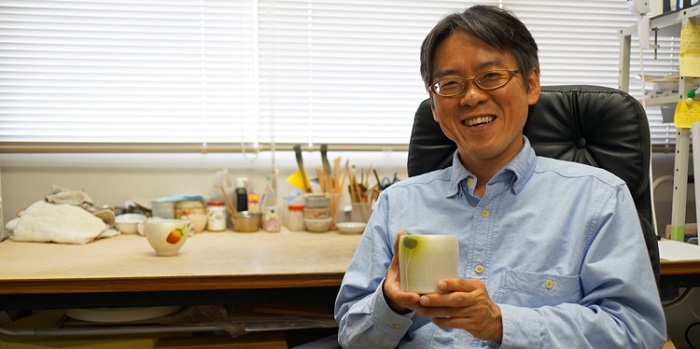
We talked to Associate Professor Yutaka Idogawa of the Art Education Major, Graduate School of Education.
(Interview: September 30, 2015, by PR Group)
Introduction
Associate Professor Idogawa specializes in crafts education and research into expressive techniques in ceramics. While passionately undertaking education and research at this university, he produces ceramic works including pots and tableware depicting seasonal vegetables. At the 62nd Japan Traditional Art Crafts Exhibition (*), his “Gindei-Saiji-Bachi” (Silver-painted Porcelain Bowl) depicting daikon radish sprouts won the Prince Takamatsu Memorial Prize, which is awarded to the best work in the exhibition.
*The Japan Traditional Art Crafts Exhibition has been held annually since 1954 by the Japan Kogei Association, in accordance with the spirit of the Act on Protection of Cultural Properties. It is Japan’s biggest exhibition of works submitted by the public for the purpose of protecting and nurturing crafts of great historic and artistic value, and is divided into seven categories: ceramics, textiles, lacquerware, metalwork, wood and bamboo crafts, dolls, and other crafts.
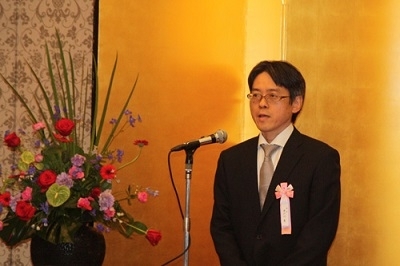
Associate Professor Idogawa makes a short speech at the award ceremony.
While many potters turn professional, Associate Professor Idogawa has chosen to remain dedicated to his vocation as a researcher and educator. We interviewed him about the sense of fulfillment that he gains as a researcher and educator, the difficulties he faced over the course of his journey to winning this prize, and his future goals, as well as the appeal of his works.
Daikon radish sprouts painted on a bowl enveloped in a silver luster
The production of a work starts with sketching. He painstakingly draws each individual, subtly different line of the daikon radish sprouts. Next, he applies color to the leaves and stems of the daikon radish sprouts, using gold paint (a paint made from powdered gold dissolved in water) for the stems. Associate Professor Idogawa explains, “This is because using gold creates a translucent white color when the bowl has been fired.” It is an important color for creating the effect of succulent sprouts growing freely. He then paints the surface of the bowl with silver paint (a paint made from powdered silver dissolved in water) and fires it, adjusting the temperature of the kiln to keep it at the right level and create the finished work. This technique involving the use of silver paint is called “Gindei-Saiji” (silver-painted porcelain) and Associate Professor Idogawa incorporated the term into the name of the prize-winning work. The silver luster enhances the beauty of the bowl, bringing out its allure.
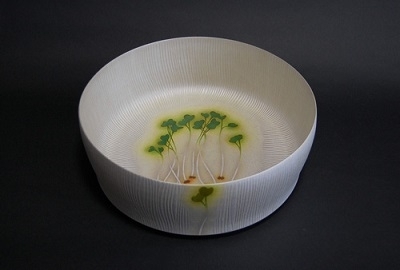
Prize-winning work: “Gindei-Saiji-Bachi” (Silver-painted Porcelain Bowl) (diameter 41cm)
A new challenge! Expressing the “unique curves of sprouts” on the side of a bowl
The prize-winning work is 41cm in diameter. Being considerably bigger than the bowls that we use in daily life, it is quite eye-catching. “This was a new challenge for me, so it was the part that I took the greatest care over,” says the associate professor, talking about the curve of the side of the bowl. Rather than being a simple curve, it seems to trace the shape of the stems of the sprouts. “The stems of sprouts are wavy, rather than being dead straight. I wanted to express the ‘unique curves of sprouts’ not only in the drawing, but also in the lines of the bowl,” he says. He succeeded in creating a bowl with soft lines that brings out in full the charm of sprouts in a form brimming with originality.
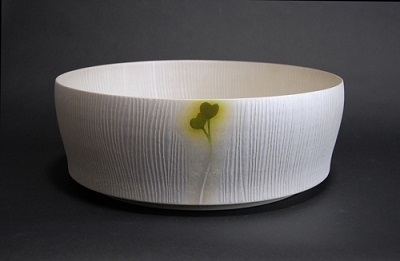
The side of the bowl depicting the curves of the sprouts
“In ceramics, you don’t just think about the design; you have to create the form as well. One of the key parts of the appeal of ceramics is thinking about what form it should take and trying out various options,” says Associate Professor Idogawa. From drawing the picture to firing the pot in the kiln, various processes are involved in creating a piece of pottery. Of these, Associate Professor Idogawa says, “Creating the form on the wheel is the part I enjoy the most.” “Pulling the wheel to make it turn is almost a sport in itself. I like the feeling of using my body to create something.”
Common vegetables as the motif of his designs
Vegetables are the subject of most of the associate professor’s works, not just this prize-winning work. “It’s because a lot of people were drawing flowers, but hardly anyone was drawing vegetables,” he says. The first work he tried with a vegetable design went down well, so since then he has used various vegetables as motifs in his designs, including chili pepper, maize, Chinese lantern, broccoli, asparagus, and strawberries.

Chili pepper and Maize
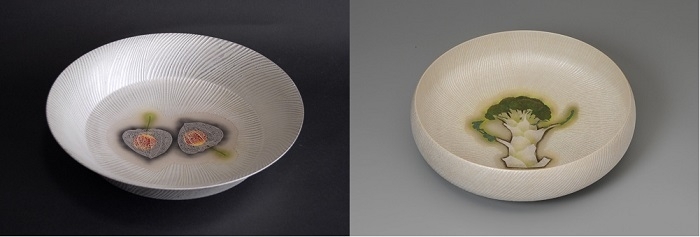
Chinese lantern and Broccoli
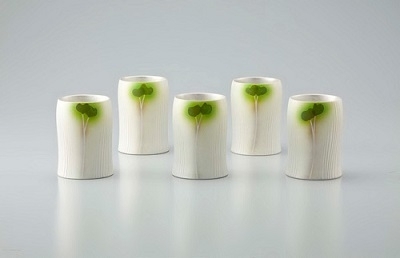
“Gindei-Saiji-Kaiwaremon-Mukozuke” (Silver-painted Porcelain Side Dishes with a Pattern of Sprouts), for which Associate Professor Idogawa was awarded the TOKI Oribe Prize in the 8th Contemporary Teaware Exhibition
Roadside stations: a treasure trove of inspiration
Associate Professor Idogawa cites ideas, materials, and skill as the three elements that create a good work. Adequate knowledge is required to ensure proper handling of the materials, while skill is acquired through long years of training. So where does Associate Professor Idogawa get his ideas from? It turned out that the answer lay quite close at hand: roadside stations, the rest areas found along roads and highways that generally sell local produce. The associate professor often visits them. “If you go there, you can see plenty of seasonal vegetables. The vegetables you find at roadside stations are full of character. They’re big and have irregular shapes, and look freshly picked. And unlike the kind of vegetables you find in supermarkets, they generally still have the tufts and roots attached,” he says. With lots of vegetables with interesting features on display, roadside stations are a treasure trove of inspiration for Associate Professor Idogawa. After he has purchased some vegetables, he settles down to sketch them before they change color. Daikon radish sprouts change color very quickly, so he says that he struggles to depict their precise shade when fresh.
The associate professor also cites composition as an important point when drawing vegetables. This is because the overall effect varies considerably according to the position of the picture and the number of vegetables in it, even when using exactly the same vegetable as the subject. “For example, you can express a profound sense of weightiness if you paint just one vegetable right in the middle. On the other hand, if you paint a row of several of the same vegetable, you can add a touch of prettiness to it. I take care to create a composition in which one vegetable in particular stands out as having the starring role. If the star vegetable looks good, I don’t really need to do very much in terms of rendering it creatively,” says Associate Professor Idogawa, disclosing his secret.
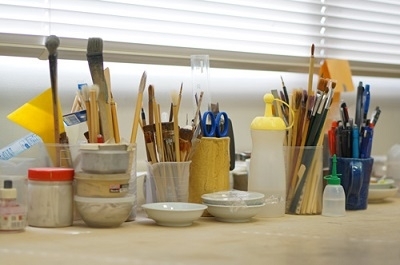
Just some of the art supplies lined up on his desk in his office
The magnificent power that crafts hold for people
“There’s enjoyment to be gained by simply looking at ceramics, but the best thing of all is to actually use them,” says Associate Professor Idogawa. It makes him happiest when people use the works they have bought from him, rather than just putting them on display. He himself found his way into the world of ceramics via the sense of attachment gained from being able to use something that he had made. However, soon after completing his graduate school course, “I thought about quitting many times, because my works weren’t very well received,” he says. Just at that time, something happened to make him decide to persevere with ceramics.
There was an elderly collector who often attended the associate professor’s exhibitions. “Although I was still an unknown at that stage, this gentleman was often kind enough to buy my works. However, one day, I received news of his death from his wife, who told me, ‘After my husband’s cremation, I placed his bones in one of your pieces.’ Some time previously, this collector had bought a cold water jar of the kind used in tea ceremony that I had made and asked his wife to use it as an urn to house his mortal remains after his death,” the associate professor reminisces. This event gave him a renewed sense of the wonder of crafts and provided him with the impetus to keep going. “Crafts can have a magnificent power over people that’s hard to put into words; it’s as though simply having a particular piece makes you feel that living is fun or that you’re not afraid to die. I think that is precisely what makes crafts so wonderful,” he says.
There is an epilogue to this anecdote: some time after that, the man’s wife contacted the associate professor again. This time she said, “I want you to make a big urn so that both my remains and my husband’s can be put in it once I die.”
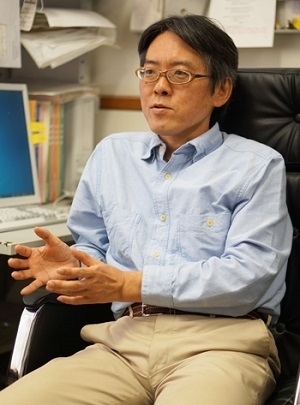
Associate Professor Idogawa talks about the power of traditional crafts.
Traditional crafts express the “now” in which we live
Even now, Associate Professor Idogawa still experiences numerous setbacks in producing his works, such as times when the color is not what he had intended and times when his works crack in the kiln. And just because he has at last produced a finished work is not to say that it will be appreciated. “It must have taken me something like 20 years to develop this style. I’ve gone through a process of trial and error, changing things gradually here and there, building up the output that has culminated in what I create now,” he says. The motto to which he has consistently adhered for more than 20 years is “expressing the ‘now.’” “The works that I make are traditional crafts, so they have to be based on traditional techniques. But that alone is not enough. I believe that the role of traditional crafts is to express and communicate in each work that precise moment in the ‘now’ in which we’re living,” emphasizes the associate professor.
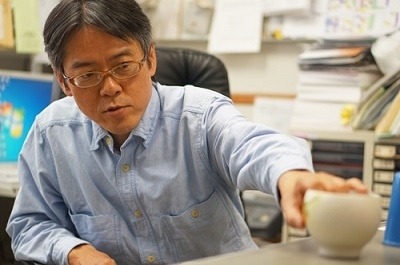
Associate Professor Idogawa gazes at one of his works as he talks about his motto.
Deriving real joy from being a university lecturer and researcher
Aside from being a potter, Associate Professor Idogawa is also an educator and researcher. “There are tremendous advantages to being based in a university,” he says, citing the opportunity to encounter a younger sensibility through contact with the students, as well as new insights gained from talking to faculty members in other fields, including sculpture, painting, and art history. As well as teaching practical classes in producing works and modes of expression, he also gives classroom-based lectures on such topics as the theory of craft. “I get my thoughts in order while I’m preparing materials for my lectures. Sometimes I even put them down on paper in an article. If I wasn’t a university lecturer, I’d probably never have given any lectures or written any academic papers,” he says. He tells us that although it means he has less time for producing his works, it gives him food for thought and broadens his horizons.
Associate Professor Idogawa says that he takes care to value each student’s own sensibility when he is teaching classes or providing guidance to students. “Without skill, it’s difficult to give shape to your ideas. That’s why I provide technical support, of course, but I don’t tell them that they should do it this way or that way,” he says. While communicating with the students, he remains aware of the precept of respecting each person’s individuality.
The desire to convey the appeal of crafts to the next generation
As time passes, the silver-painted works change color. “I’m currently thinking about what I can do to prevent this discoloration. I hope to get some advice from experts in the field of medicine, dentistry, pharmacy, or engineering,” says Associate Professor Idogawa, talking of his plans. Describing his future goals, he continues, “Apparently, the second character in the Japanese word for tradition (the ‘to’ in ‘dento’) also means ‘good’ or ‘splendid.’ Through my works, my classes, and my research, I want to convey the appeal of crafts to the next generation and to pass on to them that goodness and splendor,” he adds, with a smile.

His office is full of works at various stages in their journey toward completion.
Afterword
While we were talking about the types of vegetables that he draws, I took the opportunity to make my own suggestion, asking, “What about cherries or burdock root as subjects?” Associate Professor Idogawa replied politely even to the views of an amateur, saying, “That would be quite interesting, too! But perhaps they don’t have quite as much to distinguish them as strawberries for example....” He talked cordially throughout our interview. I was totally captivated by this kindly educator as he described his perspective on the world through the prism of crafts. (i)


 Home
Home

